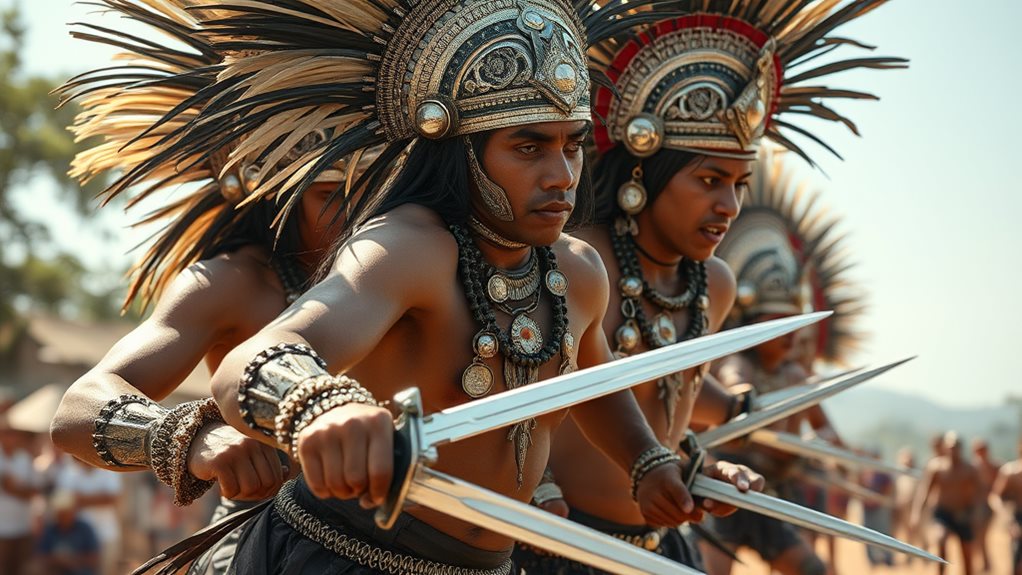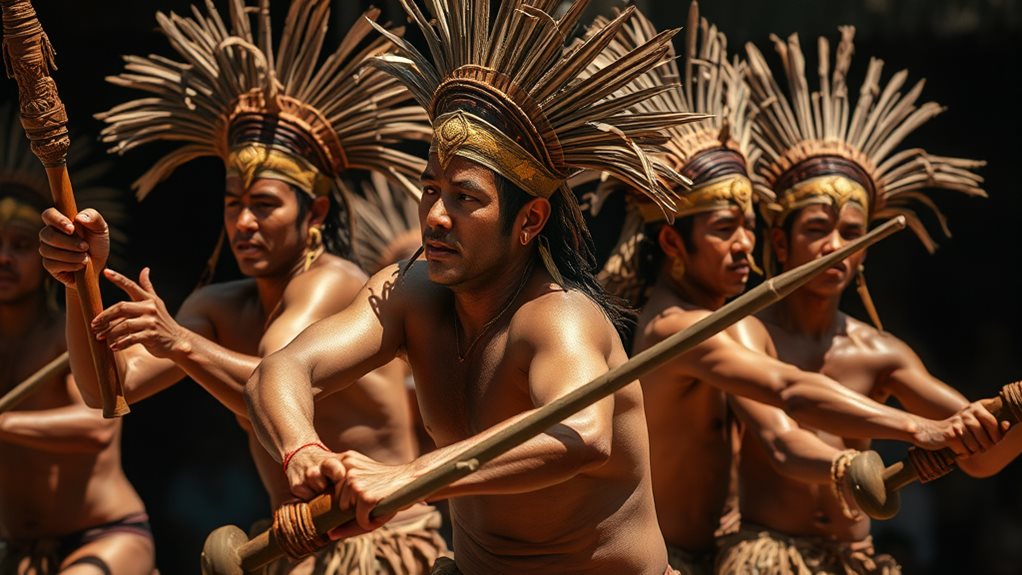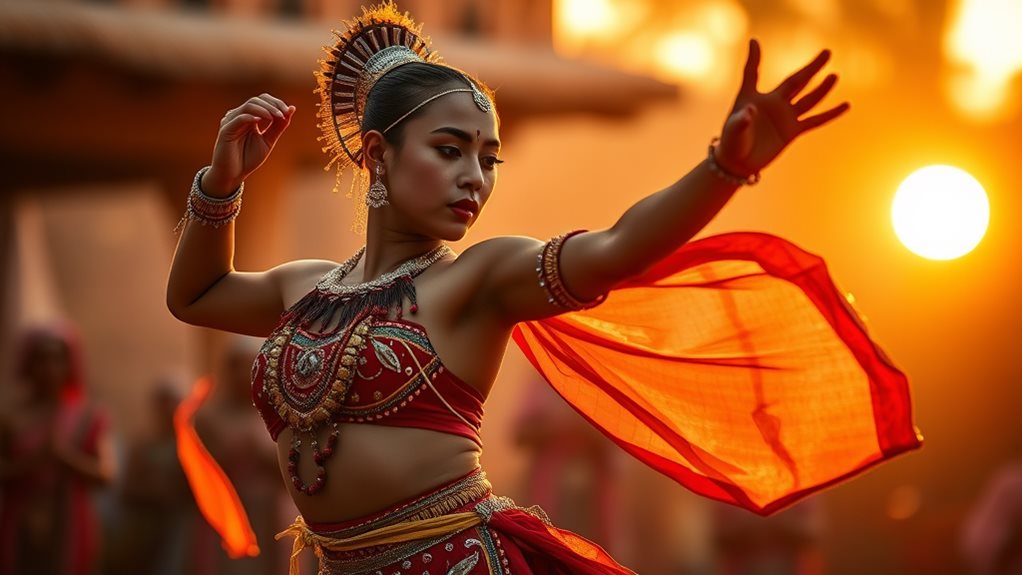Traditional Mindanao war dances showcase the region's rich cultural heritage and martial traditions**. These dances, often performed before battles, not only demonstrate unique footwork** and gestures but also highlight the community's history and values.
The Subanon's Sohten is a pre-battle ritual dance that emphasizes unique footwork. This dance is characterized by its intricate steps, which are meant to prepare the warriors for combat.
The T'boli's Kuntaw simulates combat with powerful gestures, showcasing the community's martial skills. This dance is a testament to the T'boli people's expertise in hand-to-hand combat.
The Tausug's Burung-Talo is a dance that depicts a hawk and cat fight, showcasing acrobatic self-defense techniques. This dance highlights the community's adaptability and resourcefulness in combat situations.
The Tausug's Maglangka is an elegant dance performed by Tausug girls, symbolizing their warrior spirit. This dance is a celebration of the community's female warriors and their contributions to the region's martial traditions.
Each dance offers a window into Mindanao's diverse cultural heritage and martial traditions. However, the preservation of these dances faces ongoing challenges.
Mindanao's Fiercest War Dances

Mindanao's Fiercest War Dances****
Mindanao is home to several fierce war dances that showcase the region's rich martial history and traditions. The Sagayan is one such dance, performed by the Maguindanao, Maranao, and Iranun tribes.
This dance depicts the legendary battles of Prince Bantugan****. Dancers execute intricate footwork and acrobatic gestures, mimicking combat maneuvers while wielding shields and kampilans.
The Tausug people of Sulu have their own war dance, the Burung Talo, which dramatizes a hawk and cat fight****. The dance is characterized by acrobatic movements and intense facial expressions, accompanied by the rhythmic pounding of gongs and drums.
This dance reflects the Tausug's deep-rooted warrior traditions and refined martial arts skills.
Another Tausug dance, the Panglay sa Agong, depicts a contest between two warriors vying for a woman's attention. The rhythmic banging of gongs emphasizes their courage and skill, showcasing their agility and martial prowess.
This dance offers a glimpse into the royal court's traditions.
The Kuntaw dance, originating from the T'boli tribe, is a martial arts dance that simulates combat. The name "Kuntaw" comes from the Malay word for "fist," and the dance features powerful gestures of the fist, jumps, kicks, and knee bends.
This dance is a physical representation of Mindanao's warrior traditions and a testament to the region's rich martial heritage.
Beyond the Sagayan: Binanog
The Binanog: A Rich Cultural Heritage from Panay Island****
The Binanog is a vibrant dance from the Panay-Bukidnon community of Panay Island, representing the rich heritage of this community that persevered through colonization. This dance holds significant cultural significance and showcases the community's resilience.
The Binanog features unique dance techniques, a captivating blend of storytelling and movement, which is essential to its cultural identity.
Three Main Forms of the Binanog****
The Binanog has three main forms: Binanugan, Inagong Sayaw-Sayaw, and Dinagmay.
Binanugan mimics the majestic flight of the Philippine Eagle. Inagong Sayaw-Sayaw transforms the eagle into a potential threat, showcasing the dance's dramatic shifts.
Dinagmay is a courtship dance that blends elements of combat and romance, reflecting the complexity of human relationships.
Traditional Instruments and Costumes
The dancers use traditional musical instruments such as gongs, drums, and bamboo to create a rhythmic foundation for their performance.
The costumes, often made with vibrant silks and rooster feathers, add to the visual spectacle.
The intricate needlework, known as Tubok, further highlights the craftsmanship and cultural depth embedded in the Binanog.
The Binanog Festival****
The annual Binanog Festival in Lambunao, Iloilo, provides a platform to witness the dance's full splendor.
The festival is a week-long celebration that showcases not only the dance but also the community's music, drama, and other traditions.
The Binanog's adaptation for stage performances maintains its traditional core while incorporating contemporary elements****, ensuring the continuation of its cultural significance for future generations.
Subanon's Sohten Ritual Dance

The Sohten is a traditional war dance of the Subanon people, originating from Margo Sa Tubig, Zamboanga del Norte. It's an all-male ritual performed before battle to plead for protection and victory from the gods. This dance reflects the strength and stoicism of Subanon men, showcasing their cultural identity.
The performance techniques of the Sohten are unique, with no set step count, as footwork responds to the agong's beat. Dancers wield shields and cut palm leaves, exhibiting movements that are soaring, combative, and ritualistic. Group formations vary during the performance.
The Sohten holds significant cultural value as a pre-battle ritual, connecting deeply to Subanon spiritual practices. It strengthens social bonds within the community and preserves cultural heritage. The dance has been adapted for cultural events, introducing Subanon traditions to wider audiences.
However, costume modifications have occurred due to modern influences, highlighting the need for consultation with local authorities to preserve authenticity.
Cultural masters like Gauden Sindod Sireg and Nilda B. Mangilay play crucial roles in transmitting the Sohten dance to future generations, ensuring its continued cultural relevance.
The Sohten also offers educational value, providing unique insights into Subanon culture and history.
Tausug's Burung-Talo and Pangalay
The Burung-Talo and Pangalay: Two Traditional Tausug Dances****
The Tausug people of the Philippines have a rich cultural heritage, with two distinct war dances, the Burung-Talo and the Pangalay, showcasing their martial and cultural traditions. The Burung-Talo is a martial dance that depicts a fight between a hawk and a cat.
The Burung-Talo originated from the Tausug tribe in Sulu and is deeply rooted in Tausug martial arts. It showcases acrobatic movements and intense facial expressions, set to the rhythm of drums and gongs. This dance reflects the Tausug warrior culture, preserving traditional combat techniques within a dynamic performance.
Historically, the Sultan's soldiers performed the Burung-Talo as a display of self-defense skills, highlighting the cultural significance of their martial heritage.
In contrast, the Pangalay is a courtship dance that offers a different perspective on Tausug identity. It is a celebration of beauty, femininity, and a tribute to the Sultan and their cultural heritage. Women, often adorned with janggay (brass fingernails), perform intricate hand movements and gestures, showcasing elegance and grace.
The janggay, reserved for ceremonial purposes, add to the dance's spiritual depth.
Both the Burung-Talo and the Pangalay are integral to understanding the rich cultural landscape of the Tausug people. These traditional dances provide a glimpse into the Tausug's history, cultural practices, and values, highlighting the importance of preserving their martial and cultural heritage.
Maglangka: Elegance in Motion

Maglangka: A Traditional Tausug Dance****
The Maglangka is a traditional Muslim dance originating from Jolo, Sulu, which literally means "to dance." It's an essential part of Tausug cultural expressions and is traditionally used to cultivate poise and elegance in adolescent girls.
Origins and Cultural Significance
Unlike the war dances *Burung-Talo* and *Pangalay*, the Maglangka showcases elegance and refinement. It's a key aspect of Tausug cultural heritage and plays a significant role in shaping Tausug identity. The dance is often performed at social gatherings and celebrations.
Dance Movements and Symbolism****
The Maglangka involves precise movements that mimic the fluidity of nature.
Dancers imitate the flight of birds, the gentle swim of fish, or the sway of branches. The dance also features intricate steps executed within the confines of a square cloth, requiring intense concentration. The movements are characterized by mincing steps, controlled knee bends, and expressive hand placements.
Costumes and Aesthetics
Traditionally, the Maglangka features elaborate Tausug attire, often complemented by colorful reed mats or Arabian carpets.
Intricate designs and decorative accessories enhance the dancer's visual appeal, contributing to the overall aesthetic. Modern interpretations may simplify the scarf's role, but the elegance of the traditional garments remains.
Performance and Purpose
The Maglangka's performance transcends mere entertainment; it's a cultural expression showcasing the dancer's skill and the rich artistic traditions of the Tausug people.
Questions and Answers
What Instruments Accompany Binanog?
Binanog dances are accompanied by traditional music instruments, including agongs, kulintang, bamboo slit drums, and cut bamboos. These instruments work together to create the rhythmic pulse that drives the dance.
How Old Is the Maglangka Tradition?
The age of the Maglangka tradition cannot be precisely determined. The origins of Maglangka are unclear, but its cultural significance within Tausug traditions indicates that it has been around for a long time.
Are Sagayan Costumes Always Brightly Colored?
Sagayan costumes are not always brightly colored. Costume variations exist, incorporating both vibrant hues and earthy tones. The use of vibrant hues in Sagayan costumes is symbolic, but earthy tones also play a significant role in reflecting the culture's rich heritage.
What Materials Are Used in Pangalay Costumes?
Pangalay costumes are made from a variety of materials, primarily natural fibers. Silks and cottons are the most commonly used materials in pangalay costumes. These materials hold great significance in the costumes, as they symbolize the dancer's cultural heritage and spiritual connection. The choice of material often reflects the dancer's roots and values, showcasing their tradition and customs through their attire.
Where Is the Sohten Dance Usually Performed?
The Sohten dance is usually performed at cultural events and festivals. These venues allow the Subanon people to showcase their heritage and share it with others. One notable example is the Cultural Center of the Philippines (CCP), which often hosts performances of the Sohten dance as a way to celebrate and preserve the Subanon's cultural traditions.